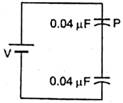The particle P shown in figure has a mass of 10 mg and a charge of –0.01 μC. Each plate has a surface area 100 cm2 on one side. What potential difference V should be applied to the combination to hold the particle P in equilibrium?

43 mV
Given,
Mass of the particle, m![]() 10 mg
10 mg
The charge of the particle, q![]() -0.01 μC
-0.01 μC ![]() -0.01
-0.01 ![]() 10-6 C
10-6 C
The capacitance of each pair of the parallel capacitor plates, C![]() 0.04 μF
0.04 μF ![]() 0.04
0.04![]() 10-6 F
10-6 F
Area of each capacitor plates, A![]() 100 cm2
100 cm2![]() 100
100![]() 10-4 m2
10-4 m2
V is the potential difference required for the particle to be in equilibrium![]() ?
?
Formula used
For the particle of mass ‘m’ to stay in equilibrium in the given set up, the weight of the particle W) should be opposed by the electric force F), acting on the same charged particle. The electric force is exerted by the electric field in between the capacitor plates. As the weight is acting downward, the electrical force should act upward for the equilibrium.
So,
![]()
Or
![]()
Where,
g![]() Acceleration due to gravity
Acceleration due to gravity![]() 9.81m/s2
9.81m/s2
q![]() charge of the particle
charge of the particle![]() -0.01 μC
-0.01 μC![]() -0.01
-0.01 ![]() 10-6 C;
10-6 C;
m![]() 10 mg
10 mg![]() 10×10-4kg;
10×10-4kg;
E![]() Magnitude of Electric field in between the capacitor plates;
Magnitude of Electric field in between the capacitor plates;
But from Gauss’s law, we have,
![]()
Where,
Q![]() Charge on the capacitor plates same on both capacitors for series arrangement)
Charge on the capacitor plates same on both capacitors for series arrangement)
ε0![]() Permittivity of free space
Permittivity of free space![]() 8.85
8.85![]() 10-12Fm-1
10-12Fm-1
A= Area of the plate in the parallel plate capacitor![]() 100
100![]() 10-4 m2
10-4 m2
We know that, for capacitors connected in series across the voltage V, the effective capacitance, Ceff will be
![]()
Or,
![]()
Here C1=C2= C = 0.04 μF
Hence,
![]()
Or,
![]()
With this, we can calculate the value of charge stored Q) in the given capacitor arrangement as,
![]()
Where, V is the potential difference required to produce enough electric field to oppose the weight of the particle.
Putting eqn.3 in eqn.2, we get,
![]()
Now, substituting eeqn.4 in eqn.1, we get,
![]()
Or,
![]()
Substituting the known values, we get
![]()
Or,
V=0.434V=43.4 mV
Hence, to keep the particle of mass 10mg, the potential difference in the set up should be 43 mV.